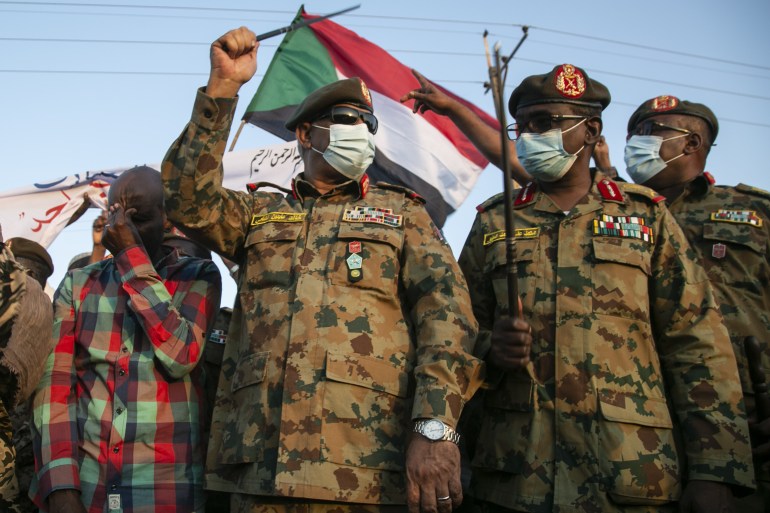Khartoum -
After military confrontations between the two neighboring countries, the Sudanese army announced that it had responded to an attack carried out by the Ethiopian forces yesterday, Saturday, on the "Al-Fashqa" area located in the state of Gedaref (east of the country), and inflicted heavy losses on the attacking force, while multiple sources confirmed the killing of a number of Sudanese soldiers. Including two officers, and wounding others.
A statement by the Sudanese Armed Forces indicated that its elements were targeted by the attacking Ethiopian force, while it was working to secure the harvest season in the Barakat Noureen area of Al-Fashqa Al-Soghra.
This confrontation came at a time when the Ethiopian federal forces are engaged in fierce battles on 3 fronts against the forces of the Tigray Liberation Front and allied forces, which seek to reach the capital, Addis Ababa, and overthrow the Abi Ahmed government.
The renewed Ethiopian attacks on the Al-Fashqa area, known for its fertile agricultural lands, coincide with the timing of planting and harvesting in the rainy season, especially after the Sudanese army re-established its control over about 90% of the lands of Greater and Lesser Al-Fashqa.
Sudan says that militias occupied it earlier, and exploited it by Ethiopian farmers.
The area of arable land in this area is about two million feddans (an acre is equivalent to 4200 square meters), and it produces various crops such as sesame, corn, sunflower and peanuts.
Ethiopian women who fled the fighting in the Tigray region work in agriculture in the fertile Al-Fashqa area on the Sudanese-Ethiopian border (Reuters)
Crisis management by crisis
In his analysis of the recent Ethiopian attack on Al-Fashqa, the strategic expert, retired Major General Amin Ismail, says that it is an attempt to manage the internal Addis Ababa crisis by creating another crisis.
On the other hand, Ismail believes that Sudan dealt with the matter wisely and intelligently, despite losing a number of its forces between dead and wounded, in addition to material losses, "because it does not want to be a party to the internal Ethiopian conflict."
Ismail described what is happening in Al-Fashqa as an attempt by the Ethiopian federal government to occupy its people and the Tigrayan forces and allied forces that are besieging Addis Ababa by fabricating battles with Sudan.
The General - to Al Jazeera Net - denied the presence of Ethiopian farmers in the Al-Fashqa area after the Sudanese army took control of it, and considered that the attack, which came under the pretext of protecting Ethiopian farmers during the harvest season, was "just a lie."
Ismail says that the so-called "Ethiopian Shifta" do not exist now (the Shifta are gangs that appeared in the fifties for the purpose of looting, and turned into organized militias with heavy weapons), and that those who attack the Shafta are regular Ethiopian soldiers in civilian clothes.
Sudanese military leaders celebrate the restoration of the border region of Al-Fashqa from Ethiopia (Anatolia)
Exploiting the area to fight the Tigray
The Sudanese army had announced that it had repelled an attack by Ethiopian forces backed by the Amhara militias last July, with the beginning of the rainy agricultural season, after they tried to penetrate into the Al-Fashqa area.
The Ethiopian attack took place in the Qalabat locality in the state of Gedaref, in the east, in an attempt to support farmers in Al-Fashqa Al-Soghra, after Sudan took control of large parts of the region.
Addis Ababa says that Sudan took advantage of the outbreak of its internal war between the federal government and the Tigray region to seize Ethiopian land and property.
The head of the Sudanese Sovereignty Council Abdel Fattah Al-Burhan and Prime Minister Abdullah Hamdok inaugurated a group of bridges in Al-Fashqa, coinciding with the army’s celebrations of the 67th anniversary of its establishment, in mid-August.
Major General Amin Ismail pointed out that the Ethiopian army directed to set ambushes and warning points and listen in on this fence, in order to trap the Tigrayan forces that pass through the western areas bordering the Sudanese borders, and try to disrupt their progress in these directions.
Amhara supported by Eritrea
The Tigray Liberation Front had recently requested the withdrawal of the federal and Amhara forces from the western region bordering Sudan, as one of the conditions for negotiations to stop the fighting between the two parties.
Retired Brigadier General Essam El Din Mirghani indicates the scarcity of available information, but he told Al Jazeera Net that the Ethiopian army and the Amhara militia are in a state of widespread and fierce battles in 3 provinces, and he ruled out that they would try to open a new front.
Mirghani said that there is information that the Amhara militia, backed by Eritrean forces, carried out the attack on Birkat Noureen in Al-Fashqa, near the Ethiopian colony of Mulkal.
The researcher on the Horn of Africa, Abdel Moneim Al-Faki, said that the Sudanese army sent military reinforcements to the region in anticipation of any escalation.
Al-Faki ruled out - in his speech to Al-Jazeera Net - that the Ethiopian army had penetrated into Sudanese territory, in agreement with the opinion that it was preoccupied with the internal war in a way that did not allow the opening of a new battle front.
The researcher suggested that the militias working for the benefit of some Ethiopian investors, who lost their interests in the agricultural lands that the Sudanese army recovered, carried out the attack.
The borders of the Greater and Lesser Al-Fashqa area extend at a distance of 168 km with the Ethiopian border out of the total border distance of Gedaref State with Ethiopia, which is about 265 km.
According to military sources, this area needs about two military divisions to protect it, and despite the Sudanese army's control of 95% of the Al-Fashqa area, some Ethiopian armed groups are trying to enter the disputed areas.

